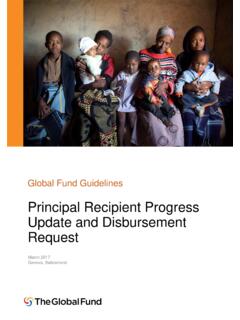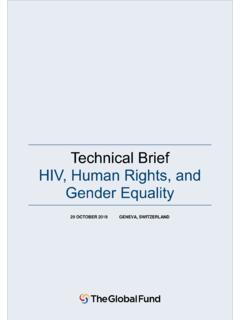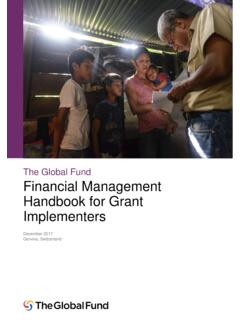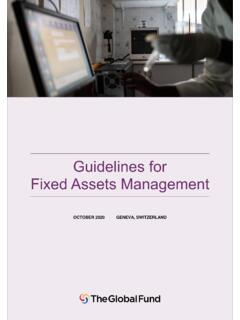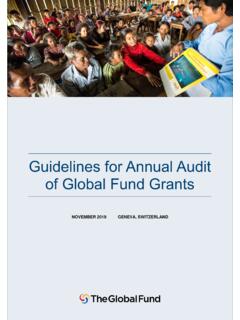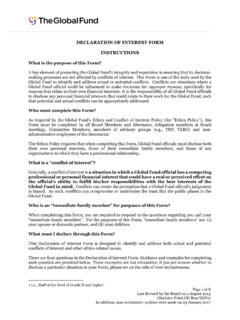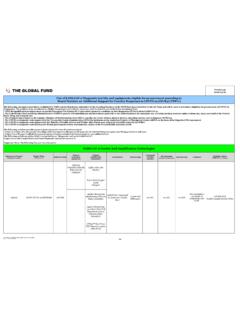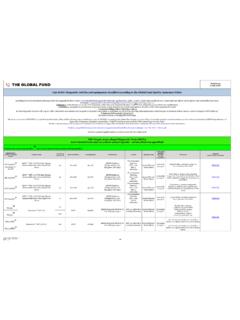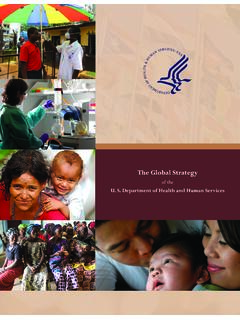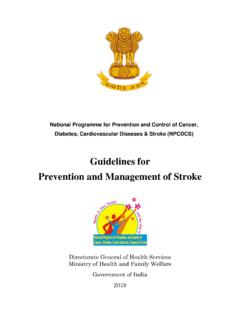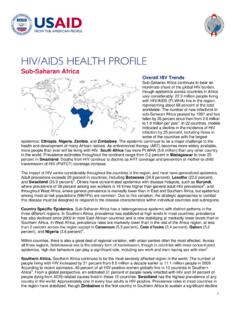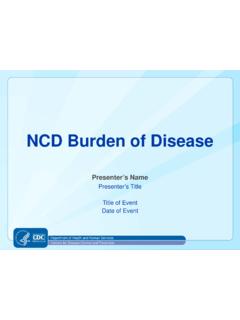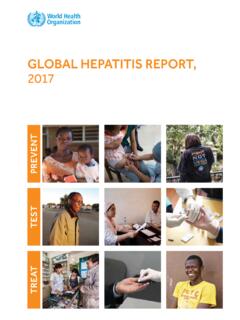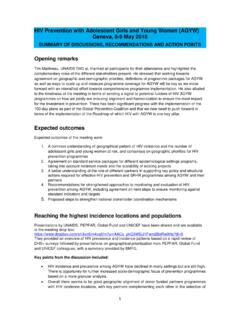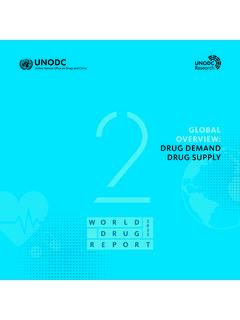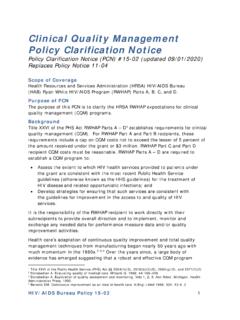Transcription of Guidelines for Grant Budgeting - The Global Fund to Fight ...
1 DECEMBER 2019 GENEVA, SWITZERLAND Guidelines for Grant Budgeting This page has been intentionally left blank Contents Allocation Model .. 8 Transition between Allocation Utilization Periods .. 10 Catalytic Investments .. 11 Prioritization Framework .. 12 Sustainability, Transition and Co-Financing .. 13 Overview .. 15 Modular Framework and costing dimension .. 15 Budget attributes and requirements .. 17 Taxes .. 18 Foreign Exchange .. 19 Allocation currency: Grant currency denomination .. 20 Budget preparation currency .. 20 Application of exchange and inflation rates .. 21 Program Management Costs .. 23 Shared Costs .. 23 Mandatory Direct Payments .. 26 Key Populations .. 26 Payment for Results .. 27 Results Based Financing .. 27 Activity Based Contracts .. 27 Incentives Payments .. 28 Differentation of Budgeting and reporting .. 29 Overview .. 31 Funding Request Budget.
2 31 1. Introduction .. 6 2. Global Fund Funding Principles .. 8 3. Global Fund Budgeting Principles .. 15 4. Budgeting in the Grant Life Cycle .. 31 Grant making Budget .. 33 Budget approval mechanism .. 34 Budget Revisions Grant implementation .. 35 Material and non-material budget revisions .. 35 Revising the summary budget .. 38 Overview .. 39 Eligibility of Grant expenditures .. 39 Recovery Process .. 44 Overview .. 46 Financial reporting principles and periods .. 46 Financial Reporting scope and frequency .. 47 Human Resources .. 48 Salaries .. 49 Allowances .. 49 Accrued Severance entitlements .. 50 Travel-related costs .. 51 Training .. 52 Technical assistance .. 55 Monitoring & evaluation .. 55 Program management and supervision .. 56 External professional services .. 57 Other considerations on financial management and monitoring of external professional services costs .. 58 Pharmaceutical, non-pharmaceutical health products and health equipment.
3 59 Buffer stock .. 61 Health equipment costs .. 61 Procurement and supply management costs .. 62 Other considerations regarding procurement and supply management costs .. 64 5. Eligibility of Grant Expenditures and Recovery Process .. 39 6. Financial Reporting .. 46 7. Specific Budgeting and Costing Guidance .. 48 Investments in supply chain 65 Infrastructure and non-health equipment .. 65 Vehicles .. 66 Maintenance cost of equipment .. 67 Other considerations on financial management, monitoring and reporting on equipment costs .. 67 Rehabilitation, renovation and enhancement for health infrastructure .. 68 Other considerations on financial management and monitoring of rehabilitation, renovation and enhancement for health infrastructure .. 68 Communication material and publications .. 69 Printed materials .. 70 Visual, audio and video materials .. 70 Other considerations on financial control and monitoring .. 71 Indirect and overhead costs.
4 71 Management fees and indirect cost recovery .. 72 Living support to client/target population .. 73 Microloans and microgrants .. 75 Cash incentives for beneficiaries .. 75 Appendix 1 - The Global Fund Costing Dimension and Investment Landscape .. 77 Appendix 2 - Transition between Allocation Utilization Periods .. 82 Appendix 3 Management of Foreign Exchange in Grants .. 87 Appendix 4 Shared Costs .. 94 Appendix 5 Activity Based Contracts .. 95 Appendix 6 - Budgetary 98 Appendix 7 - Specific Budgeting and costing guidance .. 103 Appendix 7A Indicative documentation concerning remuneration levels .. 103 Appendix 7B Template employee biographical data sheet .. 104 Appendix 7C Developing training plans .. 105 Appendix 7D Budgeting for monitoring and evaluation .. 107 Appendix 7E Vehicle needs assessment and management plan .. 111 Appendix 7F Insurance-related costs .. 114 Appendix 7G Guidance for applicants on investments in facilities/ infrastructure renovation and construction.
5 116 Relevant Links .. 120 Appendices .. 76 December 2019 Geneva, Switzerland Page 6 1. Introduction 1. These Guidelines describe financial requirements for the development, review and implementation of Global Fund-supported programs1. They aim to: allow implementers to understand the Global Fund s financial policies and procedures, and implement them in a consistent manner; enhance clarity in financial decision-making; strike a balance between flexibility and efficiency, transparency and accountability; establish clear eligibility criteria for Grant expenditures; and establish broad requirements for Global Fund grants to meet their Budgeting , monitoring and financial reporting obligations. 2. These Guidelines serve the following stakeholders: the Principal Recipients (PRs), Country Coordinating Mechanisms (CCMs)2, Local Fund Agents (LFAs), the Technical Review Panel (TRP), the Global Fund Secretariat, other Grant implementers, suppliers, agents and technical assistance providers, and any other Global Fund assurance providers.
6 3. They are intended to assist Grant implementers to develop and maintain an effective Budgeting and reporting process and to serve as a basis for the preparation of a specific Global Fund Grant budget, and budget revisions when applicable. The principles outlined apply to: (1) Global Fund Grant Budgeting , (2) Grant budget revisions, and (3) eligibility of Grant expenditures. 4. Implementers will support the dissemination of these Guidelines to relevant personnel. Regular trainings on these Guidelines need to be provided to staff involved in implementing Global Fund-supported programs, to allow the Guidelines to reach their full potential. 5. Local Fund Agents and any Global Fund assurance providers should use these Guidelines to inform their work on the implementers capacity assessment, budget review, expenditure verification, and as a complement to other Global Fund tools and Guidelines . 6. This document provides in-depth guidance on the core financial requirements for Budgeting , and should be consulted with the following Global Fund documents: a.
7 The Operational Policy Manual, which provides the operational framework for managing Global Fund grants. b. Guidelines on Country Dialogue, Funding Request development, and Grant Making. c. Pertinent clauses of the relevant Grant agreement governing the Grant . 7. The different chapters and appendices cover Global Fund funding and Budgeting principles, how Budgeting works at each stage of the funding cycle, which expenditures are eligible and recovery process in case of ineligibility, financial reporting and specific Budgeting and costing guidance, with more detailed information for areas such as human resources, travel-related costs, external professional services, and others. 1 This includes catalytic investment funding incorporated into Global Fund grants. 2 May be a Regional Coordinating Mechanism (RCM), a Regional Organization (RO) or other application coordinating mechanisms. Refer to CCM Policy Including Principles and Requirements for more information.
8 December 2019 Geneva, Switzerland Page 7 8. The provisions of the Grant agreement (including the Global Fund Budgeting Guidelines as incorporated therein) are binding between the Global Fund and the Principal Recipient3. In case of conflict between the provisions set out in the relevant Grant agreement and these Guidelines , the specific clauses of the Grant agreement shall take precedence. 9. These Guidelines amend and restate the previous Global Fund Guidelines for Grant Budgeting issued by the Global Fund in June 2017. The main changes to the revised version of the Guidelines include: a. Introduction of sections explaining the different sources of funds available from the Global Fund, how they are attributed and how they can be accessed. b. New section on Sustainability, Transition and Co-Financing. c. Introduction of a standard methodology for Budgeting , monitoring (identification, measurement, and reporting) and management of foreign exchange rate fluctuations from allocation to Grant closure.
9 D. New guidance on shared costs Budgeting , execution and reporting. e. Change in the treatment of salary top-ups. f. Mandatory direct payment requirement. g. New section on Payment for Results. h. Introduction of new thresholds for the definitions of material and non-material budget revisions for Focused countries. i. Introduction on new discretionary categories external professional services, non-health equipment j. Issuance of an implementation letter for material budget changes approval. k. Introduction of new cost inputs shared costs, severance costs, incentives, activity-based contracts. 3 Please consult with your Legal Counsel to determine whether the relevant Grant agreements include any deviations to the Budgeting Guidelines . December 2019 Geneva, Switzerland Page 8 2. Global Fund Funding Principles Allocation Model 10. The Global Fund has been implementing an allocation-based funding model since 2014. The allocation amounts for all countries are determined primarily based on disease burden and income level4.
10 They are refined to account for important contextual factors through a transparent and accountable qualitative adjustment process. 11. The Global Fund allocates funding to eligible countries to support HIV, TB and malaria programs and to build resilient and sustainable systems for health. These allocations are made every three years at the beginning of a new allocation period. 12. The total amount available for country allocations depends on the funding raised for the corresponding three-year Replenishment cycle. 13. Eligible applicants, receiving an allocation, will be notified through the Allocation Letter. The allocation letter provides an indicative distribution of the allocation amount across eligible disease components. Countries have flexibility to determine how their overall country allocation is divided among the eligible disease components, subject to written approval from the Secretariat.
